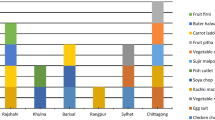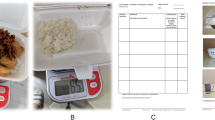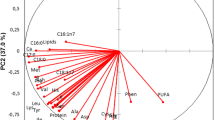Abstract
Objective: To assess the energy and nutrient adequacy of a variety of complementary foods used in parts of Africa, India, Papua New Guinea, the Philippines and Thailand.
Method: The energy, nutrient and anti-nutrient (dietary fibre and phytic acid) content (per 100 g as eaten, per 100 kcal, and per day) of twenty-three plant-based complementary foods consumed in developing countries was calculated from food composition values based on chemical analysis for the trace minerals, non-starch polysaccharide and phytic acid, and the literature. Results were compared with the estimated nutrient needs (per day; per 100 kcal) from complementary foods for infants 9–11 months, assuming a breast milk intake of average volume and composition and three complementary feedings per day, each of 250 g.
Results: Complementary foods should provide approximately 25–50% of total daily requirements for protein, riboflavin and copper; 50–75% for thiamin, calcium and manganese; and 75–100% for phosphorus, zinc and iron. Most or all appear to meet the estimated daily nutrient needs (per day; per 100 kcal) from complementary foods for protein, thiamin and copper (per day), but not for calcium, iron, and in some cases zinc, even if moderate bioavailability for iron and zinc is assumed. Some of those based on rice are also inadequate in riboflavin (per day; per 100 kcal).
Conclusions: Even if strategies to improve the bioavailability of iron and zinc are employed, they are probably insufficient to overcome the deficits in calcium, iron and zinc. Therefore, research on the feasibility of fortifying plant-based complementary foods in developing countries with calcium, iron and zinc is urgently required.
Sponsorship: This study was supported by the Micronutrient Initiative through the Canadian International Development Agency.
This is a preview of subscription content, access via your institution
Access options
Subscribe to this journal
Receive 12 print issues and online access
$259.00 per year
only $21.58 per issue
Buy this article
- Purchase on Springer Link
- Instant access to full article PDF
Prices may be subject to local taxes which are calculated during checkout
Similar content being viewed by others
Author information
Authors and Affiliations
Rights and permissions
About this article
Cite this article
Gibson, R., Ferguson, E. & Lehrfeld, J. Complementary foods for infant feeding in developing countries: their nutrient adequacy and improvement. Eur J Clin Nutr 52, 764–770 (1998). https://doi.org/10.1038/sj.ejcn.1600645
Received:
Revised:
Accepted:
Published:
Issue Date:
DOI: https://doi.org/10.1038/sj.ejcn.1600645



